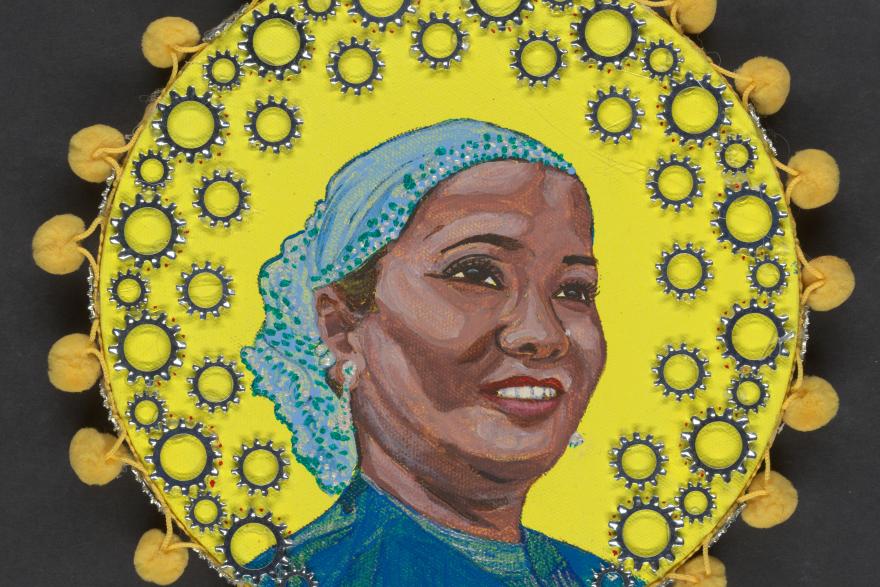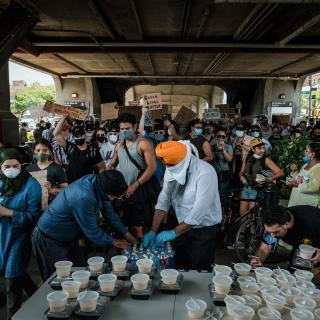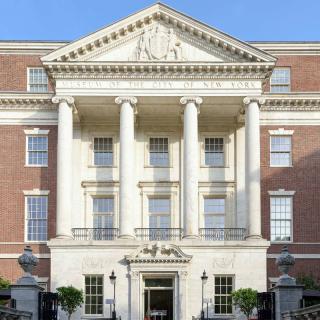City of Faith: Art and Activism

Art and Activism
In New York City, the right to religious freedom and the right to be free from religious profiling is safeguarded by a network of activists who use art and public action to further this cause. Their approach is intersectional: the fight for religious freedom, and against profiling, is interlaced with activism for living wages, gender justice, the environment, disability justice, and other causes. The particular activists featured here reject both the pressures to assimilate into whiteness and to embrace cultural exceptionalism for their communities. Instead, they adopt cross-cultural, inter-caste, and interfaith approaches, and stand in solidarity with the Global South.
Public spaces such as streets, campuses, and airports—the spaces where violence is often enacted against communities of color—are sites of activism for South Asian American and other communities. The examples here illustrate how activism and art go hand in hand towards documenting injustices and organizing for social and political change. This work transforms the city: its impact goes beyond the immediate communities, just as the impact of racism or religious profiling towards these communities ripples outwards.
LEFT
Haidee Chu
[Chhaya Executive Director Annetta Seecharran speaks at a rally outside the Sikh Cultural Center in Richmond Hill about underrepresentation of Indian and Indo-Caribbean communities]
September 13, 2022
Reproduction
Courtesy of Haidee Chu
Community members and activists from Indo-Caribbean and South Asian neighborhoods in Southeast Queens protest the NYC Districting Commission’s proposed City Council maps. These maps split the communities between two districts, thus diluting their voting power and impacting their ability to address food and housing insecurity, anti-Sikh hate crimes, and other pressing issues.
Making art is a critical part of the community-building, organizing, envisioning, and messaging work of the activists and organizations featured in this exhibition. Here we see a small sample of the many posters, zines, and other artworks produced by activists. The featured works show the breadth of these activists’ focus. Alongside religious freedom and freedom from religious profiling, this focus includes: gender justice; rejection of policing and instead embracing community-based services; raising awareness of caste oppression as a critical issue in the U.S.; and campaigning against policies that negatively impact immigrant communities and working families.
DJ Rekha / Chiraag Bhakta, *Pardon My Hindi
Bhangra Against Bush [front and back of postcard for Basement Bhangra, club night]
2004
Reproduction
Courtesy of DJ Rekha/Sangament Media
Desis Rising Up and Moving (DRUM)
FAR LEFT
“#Free Prakash Defund the Police”
LEFT
“Defund the Police”
TOP
“Who Keeps Us Safe? Dispatch from Rose, 25-Year-Old Trans Bengali Drum Brooklyn Member”
2021
Reproduction
Courtesy of DRUM
TOP
Shurmmi M, Mon M, and Thenmozhi Soundararajan
End Caste Apartheid
Undated
Reproduction
Source: Equality Labs website
Equality Labs creates Dalit (“untouchables”) and Muslim resistance art. This piece raises awareness of how caste oppression has followed many South Asian communities into the U.S. and continues to impact them here, and how legal protection of caste in the U.S. is needed to combat this discrimination.
Jaishri Abichandani
Jasmine Blooms at Night
2017–ongoing
Mixed media on canvas
Courtesy of the artist
These portraits are from a larger series depicting South Asian American feminist activists. The subjects featured here trace their roots to Bangladesh, India, Nepal, Pakistan, or Sri Lanka. Their activism is both deep and wide-ranging, covering issues related to race, religion, and caste alongside gender, housing, and labor justice.
The artist is herself an activist: in 1997, Abichandani founded the South Asian Women’s Creative Collective (SAWCC) in London and New York, to provide a platform for a community of artists that had been historically excluded by mainstream art institutions.
1. Pabitra Khati Benjamin
Former Executive Director of Adhikaar, a feminist organization in Jackson Heights’ Nepali-speaking community promoting human rights and social justice.
2. Yalini Dream
Performance artist, activist, organizer, and educator who focuses on healing and empowerment within communities contending with violence and trauma.
3. Thanu Yakupitiyage & Rafa Kidvai
Brooklyn-based DJs, best friends, and social justice activists.
4. Robina Niaz
Founder and Executive Director of Turning Point, the first community-based organization in New York City addressing domestic violence against Muslim women and children.
5. Kazi Fouzia
Formerly a community organizer in Bangladesh. Now Director of Organizing at Desis Rising Up and Moving (DRUM).
6. Thenmozhi Soundararajan
Dalit (“untouchables”) rights activist, storyteller, songwriter, technologist, and Executive Director of Equality Labs—a civil rights organization fighting caste apartheid, Islamophobia, white supremacy, and religious intolerance.
7. Thahitun Mariam and Shahana Hanif
Best friends and Bangladeshi feminist community organizers. Hanif is the first Muslim and Bangladeshi American Councilwoman in New York City.
8. Annetta Seecharran
Executive Director at Chhaya CDC, an organization addressing housing and economic needs of low-income South Asian and Indo-Caribbean New Yorkers.
9. Bhairavi Desai
Executive Director and founding member of the New York Taxi Workers Alliance.
10. Monami Maulik
Founding Director of Desis Rising Up and Moving (DRUM).
Chitra Ganesh and Mariam Ghani
Index of the Disappeared
2004–ongoing
Paper, marker, and twine
Courtesy of Chitra Ganesh and Mariam Ghani
ARTIST STATEMENT
This piece foregrounds the difficult histories of immigrant, “other,” and dissenting communities in the US since 9/11, as well as the effects of US military and intelligence interventions globally. Through official documents, secondary literature, and personal narratives, it traces how censorship and data blackouts enable a broader shift to secrecy that allows for disappearances, deportations, renditions, and detentions on an unprecedented scale. The Index is built on the work of others actively engaged in political and legal challenges to these policies, and draws on radical archival, legal, and activist traditions to select, group, and arrange information.
While the Index has become increasingly comprehensive over the years, covering everything from black sites to Bagram, corporate surveillance to contract translators, Pelican Bay to the Pentagon Papers, the point is not to collect everything relevant released into the public domain, but to sort through masses of information to retrieve bits of significance, and to make the connections that allow others to understand that significance. This iteration of the Index also focuses on surveillance operations within New York City.
INSTRUCTIONS FOR USE
The artists invite you to study the materials in the folders. Please remove materials from one folder at a time, leaving the folders on the wall, and use the ledge to review and read. Return materials to their location before turning to another folder. Please refrain from altering documents.
TOP
Amarnath Ravva
[Videos from the series “Quilts”]
2021
Courtesy of Amarnath Ravva
These videos correspond to the events and themes explored in CURB, the book located in the center of this room.
ARTIST’S STATEMENT
We like to locate violence or tragedy as if it is exceptional, an aberration. We give it coordinates, we draw a chalk outline of our victims, we memorialize the place with photos, the flames of candles, plucked flowers. What lies beyond the coordinates we choose? The video pieces I made attempt to de-territorialize how we perceive violence; to highlight its ubiquity, its diffuse presence in our lives. I chose to gather, virtually, at the coordinates found in CURB, satellite imagery and video, in conversation with Divya’s poetry.
BOTTOM
Vivek Vellanki and Tayla Blewitt-Gray, audio by Carolyn Chen
40°44′57″N, 73°53′27″W 2022
Run time: 2:06 minutes
Courtesy of Vivek Vellanki, based on “Curb 4,” written by Divya Victor
This short film presents “CURB 4,” a poem that remembers Sunando Sen, a 46-year-old South Asian New Yorker who was pushed by a woman onto the tracks of an oncoming number 7 train in Queens in a hate crime. Sen had moved to New York City twenty years prior from India, to pursue graduate studies. He later ran a copy center on the Upper West Side. As an only child whose parents had died before he moved here, New York was Sen’s home. He was “a son, a printshop owner, a roommate, traveler, entrepreneur, immigrant...”
Intersections: Mapping Activism
Organizers, communities, and the public make space for activism in the city in multiple ways. When starting out, activists may meet in temporary or makeshift spaces. Once more firmly established, they often work in more permanent offices located within their communities and neighborhoods. But as this wall shows, they also claim public space in the city's streets, parks, airports, and campuses to assert their causes.
The images and media here also provide a glimpse into the major issues around religious freedom and profiling that activists have addressed in recent years. And they portray some of the many individuals and organizations that come together to focus on these issues.
Avenue C Plaza
In Brooklyn’s Kensington neighborhood, members from diverse communities came together to transform the intersection of McDonald Avenue and Avenue C into an inclusive public plaza. Sitting just inside the Flatbush eruv and in proximity to several mosques, Avenue C Plaza has been described by local Bangladeshi American resident and City Council Member Shahana Hanif as another kind of crossroads: a space where surveilled Muslim immigrant working families can gather openly—especially women, who are at times doubly surveilled by being subjected to patriarchal norms within their communities. It joins Diversity Plaza in Jackson Heights and similar spaces throughout the city as an important anchor for South Asian American communities and their neighbors.
Activities include interfaith and cross-cultural events, focusing on art, community-building, and visions of a society free from Islamophobia, anti-Semitism, and other forms of racially motivated hate. In a neighborhood with few open spaces, the Plaza is also simply a space for casual gatherings.
TOP RIGHT
Rosa Cantor
[Students from PS 164, the Caesar Rodney school in Brooklyn performing in a Dia de las Madres event]
May 11, 2019
Reproduction
Courtesy of the photographer
RIGHT
Desis Rising Up and Moving (DRUM)
[Gender justice workshop]
November 3, 2019
Reproduction
Courtesy of DRUM
DRUM’s Brooklyn-based female members organize a public workshop at Avenue C Plaza to take on gender justice issues within their communities.
RIGHT
Liz H. Strong
[Shahana Hanif oral history interview]
April 17, 2018
Run time: 11:58 minutes
Brooklyn Public Library, Center for Brooklyn History. Muslims in Brooklyn oral histories, 2018.006.15.
In this excerpt, Shahana Hanif describes growing up in a Bangladeshi American Muslim neighborhood in Brooklyn. She discusses her love of public space and the outdoors, and how her community worked with other groups to create Avenue C Plaza.
LEFT
Unknown photographer
[Satjeet Kaur, former Executive Director of the Sikh Coalition, speaking at the “Safety in Solidarity Rally”]
December 31, 2019
Reproduction
© The Sikh Coalition
Leaders from Sikh, Muslim, Jewish, and Christian communities gather at Grand Army Plaza in Brooklyn to speak out against a spate of anti-Semitic attacks in New York City.
The Fight Against the “Muslim Ban”
After former President Donald Trump signed an Executive Order in January 2017 barring foreign nationals from seven predominantly Muslim countries and all refugees from entering the United States, a multi-ethnic, inter-faith, and cross-cultural group of activists and protestors responded forcefully. These images show the variety of responses in public space—from demonstrations and temporary legal help desks at John F. Kennedy International Airport (JFK) to public prayer as a form of protest. The protests continued in various forms and spaces until the order was revoked in 2021.
1. Unknown photographer
[Lawyers work in shifts to provide 24/7 legal help for detained immigrants and passengers at JFK Airport]
January 27, 2017
Reproduction
Courtesy of New York Immigration Coalition
2. Stephanie Keith
[Protestors rally at JFK airport against Muslim immigration ban]
January 28, 2017
Reproduction
Getty Images
3. Kelly Lunde
[DRUM organizer Kazi Fouzia prays publicly during a protest against the Muslim Ban at JFK airport]
2017
Reproduction
Courtesy of Kelly Lunde
4. Damon Dahlen
[Asad Dandia, a Pakistani American community member of the Islamic Center at NYU leads prayers at the “Jummah Prayer: NoBanJFK, 1 Year Later” event in Washington Square Park]
January 26, 2018
Reproduction
From HuffPost. © 2018 BuzzFeed. All rights reserved. Used under license.
TOP LEFT
Unknown photographer
[New York Taxi Workers Alliance protest]
Undated
Reproduction
Source: New York Taxi Workers Alliance website
This photo of a demonstration for relief from medallion debt depicts one of the many causes championed by the “multi-ethnic, multi-generational” New York Taxi Workers Alliance (NYTWA), a union founded in 1988. NYTWA serves “yellow cab, green car, black car, livery and app-dispatched drivers.” Members come from a wide cross-section of communities, including South Asian Americans, Sikhs, Hindus, and Muslims. NYTWA also takes “collective action over non-traditional worker issues,” for example, organizing protests against wars and against racism targeted towards Muslims and Sikhs.
BOTTOM LEFT
Ero Partsakoulaki
[Vigil in Union Square]
April 24, 2019
Reproduction
Courtesy of Ero Partsakoulaki
One of the largest Sri Lankan diasporas in the world is on Staten Island. In this photograph, activists from the community organize a candlelight vigil in Manhattan to remember the victims of ISIS-linked suicide bombings in Sri Lanka. They also made space to reflect on decades of state-driven trauma, conflict, and pain.
TOP
Unknown photographer
[Diala Shamas from the CLEAR project stands with Asad Dandia, one of the lawsuit’s plaintiffs, the ACLU’s Hina Shamsi, and Imam Raza, another plaintiff in the lawsuit]
June 8, 2013
Reproduction
Courtesy of the American Civil Liberties Union
After 9/11, the New York Police Department launched an unwarranted secret surveillance program against New Yorkers from Muslim-majority countries and “American Black Muslims.” Labeling them people with “Ancestries of Interest,” the police embedded spies and informants within these communities and mapped their neighborhoods. When these practices came to light, they caused intense trauma within the affected communities. In 2013, City University of New York’s Creating Law Enforcement Accountability & Responsibility (CLEAR), the American Civil Liberties Union (ACLU), and New York Civil Liberties Union (NYCLU) successfully sued the NYPD on behalf of Muslim community leaders, mosques, and a charitable organization.
This photograph shows some of the people behind the lawsuit, including Diala Shamas (then at CLEAR), Art Eisenberg (NYCLU), Ramzi Kassem (CLEAR), Hina Shamsi (ACLU), and some of the plaintiffs: Asad Dandia and Imam Hassan Raza. Also present but not pictured here was Linda Sarsour (representing the Arab American Association of New York).
BOTTOM
Alyssa Schukar
[Rally in Illinois for a hate crime survivor]
September 15, 2015
Reproduction
© The Sikh Coalition | Photo Credit: Alyssa Schukar Photography
The first person killed in the wave of hate crimes that swept the US after 9/11 was American citizen and member of the Arizona Sikh community, Balbir Singh Sodhi. The Sikh Coalition, a New York City-based advocacy organization, formed on the night of September 11, 2001 in response to early reports of bigotry, discrimination, and hate violence. Since then, the Sikh Coalition, along with other Sikh-focused organizations, has empowered its community across the U.S., raised cultural awareness of Sikhism, and fought the ongoing targeting of Sikhs. The Coalition also facilitated the Sikh Project portraits in the adjacent room.
RIGHT
Original website by DRUM, redesigned by Sandy Guberti Ng
“Stop the Disappearances! Organizing for Freedom in the Wake of Post-9/11 State Violence”
2021 (redesigned in 2022)
Courtesy of Desis Rising Up and Moving (DRUM)
The organizations featured in this exhibition have worked on behalf of their communities for years. This timeline shows the deep work done by one such group—DRUM—to organize for freedom in the wake of post-9/11 state violence. DRUM was founded in 2000 to advocate on behalf of “immigrants who had become the fastest growing percentage of the prison population at the beginning of the century.” Like other organizations, after 9/11 DRUM was presented with a worsening crisis. This timeline was produced by the organization on the 20th anniversary of 9/11. It has been redesigned to fit the museum experience. For the original timeline and full content, please scan the QR code.
TOP
DJ Rekha / Chiraag Bhakta, *Pardon My Hindi
Bhangra Against Bush [flyer for Basement Bhangra, club night]
2004
Reproduction
Courtesy of DJ Rekha/Sangament Media
DJ Rekha (Rekha Malhotra) organized the first Basement Bhangra event at the club SOB’s in Manhattan. In what turned into a decadeslong dance party, Bhangra music and dance from Punjab, became central to the music scene in New York City. “Basement” provided a safe space for South Asian American New Yorkers, particularly after 9/11. Its alignment with anti-imperialist and anti-war activists within the community can be seen in this flyer for a club night organized to protest the 2004 Republican National Convention.
Poems by Divya Victor, design, printing, and binding by Aaron Cohick
CURB
2019
Letterpress and rubbings
The Press at Colorado College
The poems and sidewalk rubbings in this artist’s book tell a story about the religious profiling and subsequent assaults and murders of South Asians in public spaces in the U.S. They show how everyday sites—such as curbs and sidewalks, a flower bed outside a gas station in Arizona, or a subway platform in Queens—can turn hostile for those who are not seen to belong.
The book is designed to unfold like a map and take up space. Its jagged horizon lines suggest the suddenly distorted vision of a person falling to the concrete.
Short films based on the poems are playing on the metal wall. An interactive copy of the book is available for educational tours.





